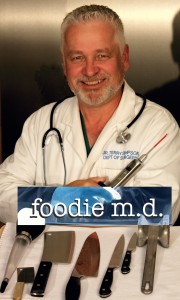
While I spend time teaching patients to cook- that is fun- but what is professionally rewarding is physicians who spend time with their patients
She came to my office nervous, and almost in tears. When she sat down she moved her heavy purse onto the desk.
When I asked how I could help her she started to cry. In the next minute she cleared up but said that she was just a mess, at the end of her rope, and her doctor had sent her to me for surgery.
Her blood pressure had been elevated for a bit, so after we talked for another minute, I asked if I could take it again. When I did the blood pressure was low-normal.
We ask new patients to bring either a list of medications, or we ask them to bring their pills to the office. I asked her what medicines she took. Onto my desk spilled thirty different prescription bottles. I am not a primary care doctor, I am a surgeon, which means I don’t prescribe medications for blood pressure, unless the patient is in the hospital with high blood pressure, or diabetes, or other ailments.
I started looking at the bottles. “How much time do you spend with your doctor?”
“Honestly, Dr. Simpson, you just looking through my bottles is more time than I ever spend with my doctor or his nurse.”
“How many of these do you take?” I asked.
“I have no idea.” She replied.
So we went through them. One by one. Many she had no idea why they were prescribed, and many she didn’t like so had stopped taking. She had four blood pressure medicines, none of which she had taken today and her blood pressure was normal. She had three different pills for diabetes, none of which she had taken in a while.
I asked why she was on thyroid medicine. “My doctor said it would help me to loose weight.”
She had brought her labs with her, so I looked through those. No thyroid tests anywhere.
Prescription after prescription- and there was no rhyme, reason that this patient understood, and yet I was looking at thousands of dollars of medications.
When getting a referral from a physician it isn’t polite to send someone to another physician – it just isn’t done. I was tempted, but found a way out of it. I called the primary care office and asked if they would mind if I made a referral to a gastroenterologist to see the patient, the busy nurse said this was not a problem. Since she was on medication for “GERD” she needed to be evaluated to see if she had a hiatal hernia before I did surgery.
“Joyce, I have a problem here, and I need your help.” When I call Joyce for help with a GI problem it is usually someone who is having a bleed and needs intervention quickly. This was different – this means the patient needed someone who was an internist, and I knew she would go through each medication, take as much time as was needed and pair down the list.
I didn’t need to prep the GI doctor, I sent the patient over. About two hours later I got a call from Dr. Richards.
“Did you see all the meds she was on? ” she started, not even naming the patient.
“I did, and many she was not worked up for.”
When the patient came back to my office, after having a scope confirm there was no ulcer, no hiatal hernia, no evidence of GERD, and the patient didn’t need the three medications given to her for stomach issues – there was also a smiling patient, who had gone from thirty prescription medications to three: one for hypertension, one of diabetes, one for hyperlipidemia.
“She spent two hours with me, and going through my history and chart.”
I smiled – I knew she would.
Taking time with patients is that – it takes time. In this case, the intervention saved this patient and the health care system dollars.
Oh- the surgery went fine- the patient came off the diabetic medication after loosing some weight, and blood pressure medication soon thereafter. The patient is also cooking, attending my cooking classes – and in the last six years since this happened has gone from someone who was unemployed and on disability to happily back at work (and down 120 pounds). Sadly, my good friend, and GI doctor moved to another city- but there are a lot of great doctors out there I know who actually love to spend time with patients.
